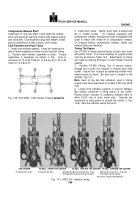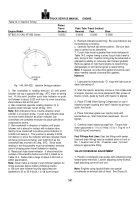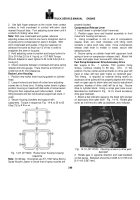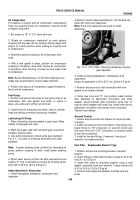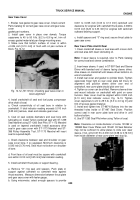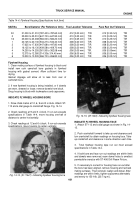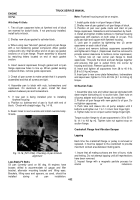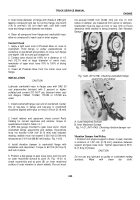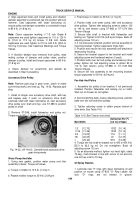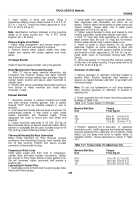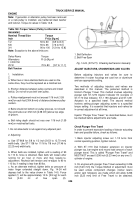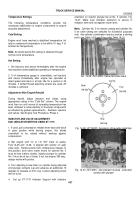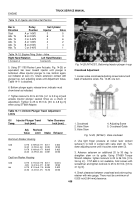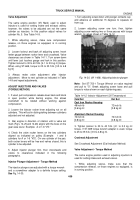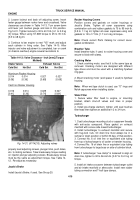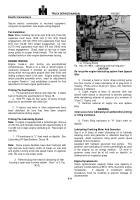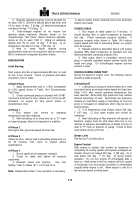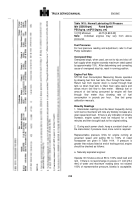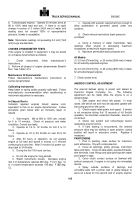TM-5-3805-254-14-P-2 - Page 410 of 894
TRUCK SERVICE MANUAL
ENGINE
Note:
If generator or alternator pulley has been removed
or a new pulley is installed, use hardened steel washer
and locknut. Torque to values in Table 14-8.
Table 148: Torque Values (Pulley to Alternator or
Generator)
Nominal Thread Size
Torque
Inch
Ft-Lb [Kg m]
1/2
50 to 60
[6.9 to 8.3]
5/8
55 to 65
[7.6 to 9.0]
3/4
90 to 100
[12.4 to 13.8]
Note:
Exception to the above limits are:
Delco-Remy
Torque
Alternators
Ft-Lb [Kg
ml
1 0 DN 150
25 SI
70 to 80
[9.7 to 11.1]
Belt Tension
1.
Installation:
2.
a. When two or more identical belts are used on the
same drive, they must be replaced as a matched set.
b. Shorten distance between pulley centers and install
belt(s). Do not roll or pry belt over pulley.
c. Pulley misalignment must not exceed 1/16 inch [1.59
mm] for each foot [304.8 mm] of distance between pulley
centers.
d. Belts should not bottom on pulley grooves, nor should
they protrude over 3/32 inch [2.38 mm] above top edge
of groove.
e. Belt riding depth should not vary over 1/16 inch [1.59
mm] on matched belt sets.
f. Do not allow belts to rub against any adjacent part.
2. Adjusting:
a. Use ST-968 for 3/8 to 1/2 inch [9.53 to 12.70 mm]
width belts. Use ST-1138 for 11/16 to 7/8 inch [17.46 to
22.23 mm] width belts.
b. When belts are installed, tighten until a reading of 90
to 110 lb. force is obtained. New belts will loosen after
running
for
an
hour
or
more
and
may
require re-
adjustment. Recheck belt tension and re-adjust to 90 to
110 lbs. if reading is less than 80 lbs.
c. As an alternate method, tighten belts so pressure of
index finger extended straight down, Fig. 14-24 will
depress belt to the value shown in Table 14-5. Force
applied (1) will be approximately 13 lb. [5.9 kg] for each
foot
[0.30
ml
of
free
span
(2).
1. Belt Deflection
2. Belt Free Span
Fig. 14-24, (N11471). Checking belt tension manually
ADJUST INJECTORS, CROSSHEADS AND VALVES
Before adjusting injectors and valves be sure to
determine if rocker housings are cast iron or aluminum
and use appropriate setting.
Two methods of adjusting injectors and valves are
described in this manual. The preferred method is
Uniform Plunger Travel. This method involves adjusting
plunger with ST-1270 Injector Indicator Kit (consists of
ST-1170 Dial Indicator, ST-1 193 Actuator and ST-1251
Actuator) to a specified travel. The second method
involves setting plunger adjusting screw to a specified
torque setting. It is essential that injectors and valves be
in correct adjustment at all times.
Injector "Plunger Free Travel," as described below, must
be checked before adjustments are made.
Check Plunger Free Travel
In order to prevent excessive loading of injector actuating
train and possible failure, check as follows:
1. Back injector adjusting screw out 1-1/2 turns from
normal operating position, tighten locknut.
2. With ST-1170 Dial Indicator extension on injector
plunger top, bar engine and record total amount of each
plunger travel. This is called "Plunger Free Travel" and
MUST NOT exceed 0.206 inch [5.23 mm] on any one (1)
cylinder of engine.
3. On engines with plunger Free Travel exceeding 0.206
inch [5.23 mm] the Torque Method of adjustment must
be used unless component changes (rocker levers
and/or cam followers) are made which will allow 0.206
inch [5.23 mm] limit of Free Travel to be obtained.
406
Back to Top

